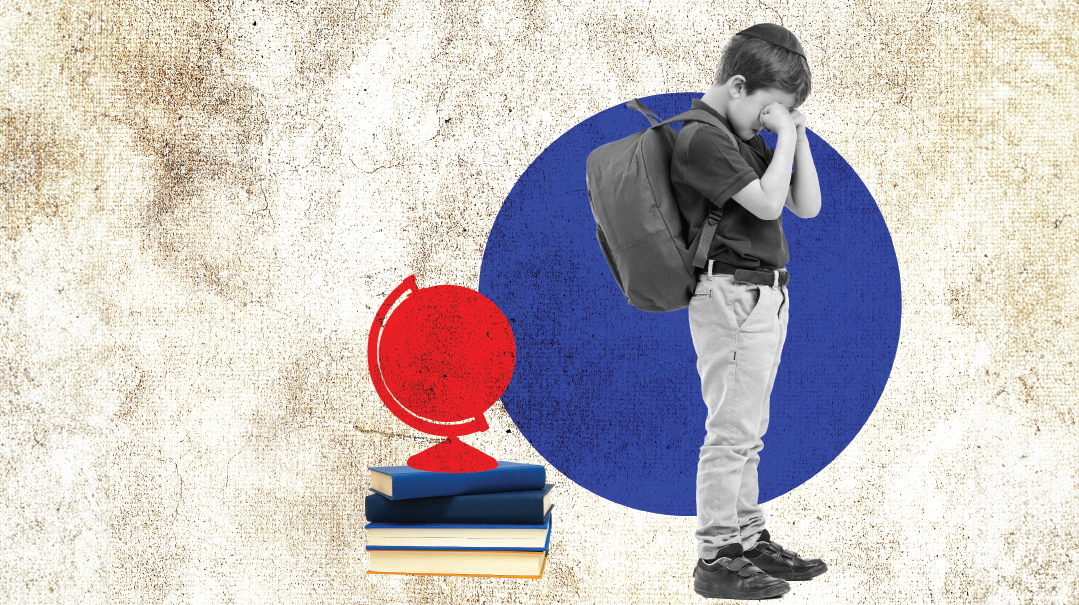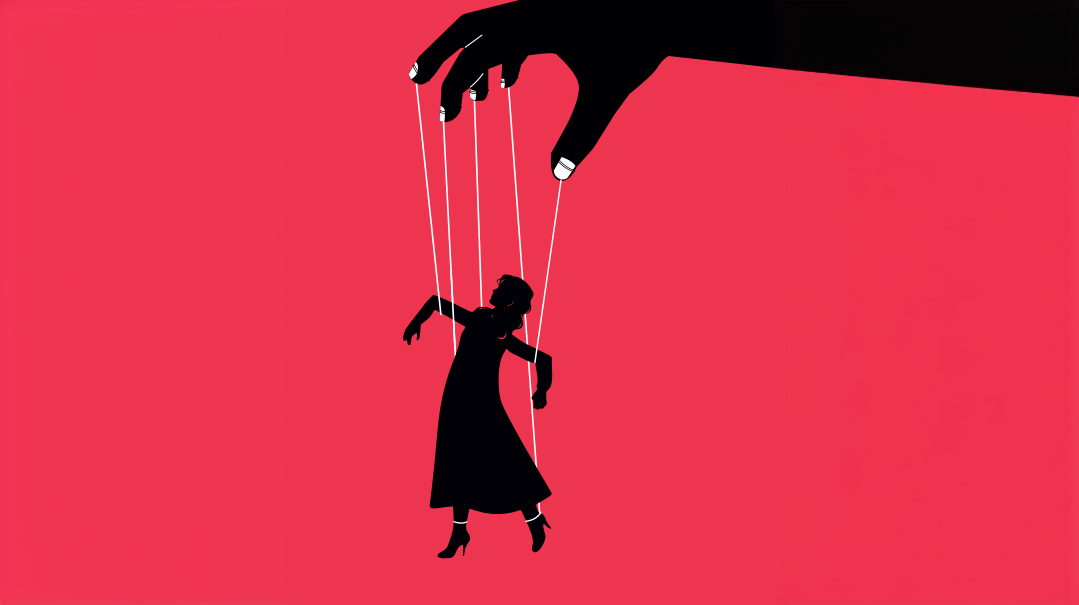Little Bullies
| November 21, 2023Rachel Atkins, founder of the Bye Bye Bullying project, shares her hands-on experience with tackling bullying in the classroom

D
evorah Cohen* was a sweet, clever six-year-old from a warm, stable family. She had every reason to be a happy kid, yet she was perpetually miserable.
She was sitting in a corner of her first-grade classroom when I first I met her, nursing her knee, and making whimpering noises. She looked the picture of woe.
“There’s nothing actually wrong with her knee,” her teacher confided to me. “I wish I could help her. She’s always fretting about something. Today, it’s her knee. Yesterday it was her stomach.”
I knew there had to be more to the picture. So I contacted Devorah’s mother for more information.
Mrs. Cohen was aware that Devorah was unhappy in school but had no idea why. She had spoken to Devorah several times to find out what was bothering her, but had failed to solve the mystery. Emotionally, Devorah was fine at home. Thinking something might be medically wrong, Mrs. Cohen brought Devorah to the doctor. But her physical checkup yielded a clean bill of health.
After I observed Devorah in school for a few days, the cause of her unhappiness became painfully clear. Nobody wanted to play with Devorah. Her classmates couldn’t stand her. If she got onto the trampoline in the playground, her peers immediately got off. “You’re yuch,” they’d say to her. “You smell.”
There were no obvious triggers. Though Devorah lacked a certain social savviness and was a bit gawky, there was nothing to explain her classmates’ strong negativity.
One day, a classmate pinched Devorah, and another spat on her. The teacher reprimanded the girls and gave the class a lesson on being kind to others, but things didn’t change much.
Things came to a head a few weeks later during a class outing. The teacher instructed everyone to take a partner for the trip. She didn’t envision any difficulties because there was an even number of girls.
But no one wanted to partner with Devorah. The teacher looked for the other “odd” student without a partner — a little dimpled girl named Faigy — and cheerfully invited her to join up with Devorah.
With a look of horror on her face, Faigy quickly hurried off to make a threesome with another pair, rather than hold Devorah’s hand. Devorah was left standing all alone by the wayside like a leper. She burst into tears.
From Lively to Limp
Over the last few decades, school bullying has received a lot of press. In the United Kingdom, where I live, schools are required by law to prevent and effectively tackle bullying. In America, all 50 states have adopted school anti-bullying legislation. Yet despite increased awareness, bullying is still a problem.
Statistics show that, in the previous year alone, at least two in five young people have experienced some form of bullying. By the age of 18, at least 45 percent of students will experience bullying.
Given the emphasis on middos in frum schools (and in our homes), it’s not surprising that our schools buck national trends, with better-than-average track records in countering bullying. But still, bullying occurs.
And it can start young. Take Shayna Schwartz*: She was such a bubbly, articulate, self-assured five-year-old that her mother wasn’t the least bit worried about her transition to kindergarten. But within weeks, Mrs. Schwartz noticed a change in her daughter’s behavior. “Shayna went from lively to limp,” she remembers. “She became subdued and fearful. She started biting her nails and crying over the smallest things.”
It was difficult to get any explanations from Shayna, but eventually she revealed to her mother that she was “scared” of several classmates. Mrs. Schwartz immediately contacted Shayna’s teacher. “It turned out that some of her peers had taken to laughing at her,” she says. “They would make fun of the most ridiculous things. For example, one day I gave her a mitzvah note for helping at home, and these girls mocked it as nebby.”
Bullied children often grow anxious or shy around other children, as Shayna did. They may start having nightmares, or refuse to go to school entirely. The emotional pain can express itself physically, too, with stomachaches, headaches, or other symptoms.
One of the most heartbreaking consequences of bullying is the blow to a child’s self-esteem. “Bullying makes you feel like a worm,” wrote one elementary-aged child. Another child put it this way: “It feels like a knife in you.” If nothing is done to stop bullying, it can have a lifelong negative impact. As one 26-year-old man confessed, “It took me a long time to get my confidence back — years, really. I still think about the bullying and get upset.”
Though Mrs. Schwartz and Mrs. Cohen both felt comfortable getting the school involved, some parents hesitate, wondering if they should intervene or let the kids work things out for themselves. That’s a common question I deal with. Indeed, a parent recently confided in me that her son was being bullied in class, so before contacting the school, she called up the bully’s mother. Despite this woman learning that her son was daily heckling other classmates, she refused to speak to her son about it. “Boys will be boys,” she replied. “I don’t believe in being a helicopter parent and hovering over my kid’s social dynamics.”
That’s a flawed viewpoint. Our goal isn’t to hover, it’s to teach. Just like children need to learn how to read and write, they need to learn appropriate social behaviors. This is especially the case with elementary school children, who often simply lack an adequate range of appropriate tools for navigating social interactions. That’s why it’s essential for effective anti-bullying programs to be implemented in every school.
Mountain or Molehill?
In 2020, I created the Bye Bye Bullying Project to help kids, teachers, and parents effectively tackle school bullying. When I speak to parents, I always start with clarifying what falls into the category of bullying. For example, say your child comes home from school complaining that someone tripped them on the playground. How do you know whether to go into full warrior mode with your guns blazing — or to treat the incident as relatively minor?
Here’s a scenario I use in anti-bullying workshops for schoolchildren, to help them identify the signs of bullying:
“ACCIDENTAL OR ON PURPOSE”
When asked, “Which picture shows bullying — number 1 or 2?” even six-year-olds will usually correctly identify the first picture, explaining their choice by saying, “because they did it davka; on purpose.”
That is, indeed, the first characteristic of bullying: It’s deliberate rather than accidental. The second characteristic is that it happens repeatedly. The third is that there’s an imbalance of power — for example, a few kids against one.
There’s a handy mnemonic for remembering the three signs of bullying, which we teach to kids in school workshops. We call it “DR. U”, pronounced — appropriately — Dr. Ugh.
Deliberate
Repeated
Unfair
Knowing the signs of bullying allows parents and teachers to differentiate between minor incidents that need a low-key response (“She bumped my elbow and my drink spilled” — likely a mistake, especially if it’s a one-time occurrence) and major incidents that need to be immediately addressed (“She takes food out of my bag at lunchtime and throws it in the garbage”).
Another way for parents to sift out the significant from the insignificant is by using the bullying temperature check.
Green
My child seems happy and content. They like to go to school and have good relationships with other children and staff. While they have the occasional situation where others say or do unkind things to them, or they have said or done unkind things to others, they have been able to resolve the situation (including saying sorry if they have hurt someone else).
Amber
My child is sometimes sad and can be reluctant to go to school. While they mention one or two friends, they seem to have regular fallouts with other children and have mentioned a number of situations where children have said or done unkind things to them, or they have said or done unkind things to other children. They seem unsure of how to resolve these situations and I am not sure they are receiving enough help.
Red
My child is often sad or upset and does not like school or their usual activities. They do not seem to have friends and I am concerned that other children often say or do unkind things to them. They urgently need help to resolve the situation and to enjoy their school and social life.
This can be especially helpful to parents when kids don’t want to talk about what’s going on, but the parents — the experts on their child — notice something is “off,” as Shayna’s mother did.
Stepping In
Aliza Green’s daughter Mimi*, a spunky, friendly, seven-year-old, never had any social difficulties either in or out of school. That is, until she attended a large, local day camp. In her group of 24 girls, only one was a classmate from her own school; the rest were from a different school. The camper sitting next to Mimi took objection to the “stranger” in her midst and started picking on her.
After the first day, Mimi came home fuming. “This girl — I don’t want to say her name because it’s lashon hara — was mean to me for nothing,” she told her mother. “I didn’t do anything to her! She said mean things to me and even scribbled on my picture. She only did it because I wasn’t from her school. The other girl from my school she knew already, so she wasn’t mean to her.”
Now how should Aliza respond to her daughter? When I give classes for parents, I ask them to imagine their child arriving home from school in a bad mood and shouting, “I hate school! I’m never going back!” and then to picture how they would reply: Would they remind their child that they need to go to school because it’s the law, dismissing their feelings entirely? Would they take this moment to criticize their child for being negative? Those responses will obviously only hurt their child and further inflame the situation. Instead, I suggest listening, reflection, and empathy: “You don’t want to go back to school, huh? Sounds like you’ve had a rough day.”
Aliza wisely went with the empathetic response: She listened attentively to her daughter and then validated her feelings. She also clarified that it’s okay to tell a mommy the name of a kid if the mommy thinks it’s necessary. (At student workshops, I explain to kids that they can say “a boy or girl did x” rather than giving a name, but if the teacher or rebbi needs to know the name, you’re allowed to tell them so they can address the issue.)
Although Aliza was concerned about what Mimi shared, she was hopeful that maybe the bullying would stop on its own. “I told Mimi that maybe the girl was going through a hard time and that she should wait another day to see if the bullying continued,” Aliza recalls.
Unfortunately, it did. “That girl said a very not nice thing to me!” Mimi told her mother the next afternoon. “It was so not nice that I don’t even want to tell you because you’ll be upset.” Aliza managed to elicit that her daughter had been called a “shtinky-pooey.”
Now firmly convinced that the day camp incidents met the signs of bullying (deliberate, repeated, unfair), Aliza knew it was time to involve the principal. But before calling, Aliza decided to give Mimi an opportunity to deal with things herself, and encouraged her to discuss the problem with the principal. Mimi was hesitant to go on her own, but after her two older sisters offered to accompany her, she plucked up the courage.
The principal listened to Mimi’s story, gave her a prize of bubbles to cheer her up, and told her she would deal with the situation. Mimi’s counselors were alerted to the bullying and asked to be extra vigilant in preventing any incidents (including moving the other girl to a different seat). From that day on, day camp proceeded smoothly. In Mimi’s own words: “The girl didn’t do any more ichy things.”
“I know it was only day camp, a temporary arrangement, and that in school it might not have been so easy to achieve a happy ending,” Aliza shares. “But still, Mimi’s whole camp experience could have been ruined by the bullying. Because the principal addressed the issue promptly, she prevented Mimi from having a horrid camp experience.”
Involving the School
Bullying can be such a traumatizing experience that some parents wish every school would adopt a zero tolerance approach, with severe punishments for bullying. However, research shows that punishing bullies generally doesn’t stop bullying. Rather, bullies need help in changing their behavior. And though we’d never blame the victim, sometimes the victims need help socially in certain areas, too.
To combat the bullying in Shayna’s classroom, the school implemented an effective anti-bullying program that focused on both short-term (reactive) and long-term (proactive) goals. They introduced weekly timetabled circle times (more on this in a moment), helped the children find healthier ways to interact with each other, and used hands-on lessons and role-play to teach the girls social skills. Outside of school, Mrs. Schwartz built up her daughter, making sure that home was her haven.
Within weeks, the whole class dynamic was more positive. Shayna stopped biting her nails as much. She slowly stopped exhibiting signs of stress and became more confident in the classroom. The school knew the program was a real success when Mrs. Schwartz called to report good news: “Shayna has a circle of friends now — and she even got a telephone call at home for the first time!”
As for Devorah, that last bullying incident galvanized the school leadership into action. After taking expert advice from anti-bullying organizations and an experienced child therapist, we devised a School Action Plan:
An initial staff meeting to get everyone on board, including lunchtime supervisors (shared goals).
A set of prescribed consequences for bullying behavior, to be implemented consistently by all staff (a short-term strategy aimed to “put out the fire” of bullying since we knew this strategy wouldn’t work on its own long-term).
A school-wide project on middos, with charts, prizes, and lots of razzmatazz (another short-term strategy).
A classroom circle time program, with timetabled weekly sessions, to teach social skills and positive interactions between pupils (a long-term strategy).
Research shows that when there’s bullying in a classroom, it’s often a reflection of a larger problem with unhealthy class dynamics. Historically, these group dynamics have been notoriously difficult to change. That’s why anti-bullying measures of the past often proved of only limited effectiveness. Like the Whac-A-Mole fairground game, as soon as you pushed down one bullying situation, another popped up. Educators were struggling to find a method to enable schools to transform unhealthy group dynamics into healthy ones.
Enter Jenny Mosley, a former UK teacher. Drawing on a model used in businesses to improve staff relations, she pioneered circle times in British schools some 40 years ago. Her Quality Circle Time model has proven to be one of the most durable and effective ways to promote positive group dynamics and eradicate bullying. Used as a basis for teaching relationship and social skills, and building a positive behavior management policy in schools and nurseries, the program has spread to countries around the world, including the US and India.
How does it work? Circle time involves children sitting together in a group, usually a circle, with one or two teachers, on a regular basis. The children carry out a structured set of whole-class interactive activities, designed to be fun and enjoyable. Often a “talking object” (a stuffed toy, seashell, toy microphone, etc.) is used to facilitate discussion about relevant issues. The talking object is passed around the circle, and only the person holding it is allowed to speak. The teachers sit in the circle with everyone else so they’re part of the group.
While the activities feel like “fun and games” to the children, who love the circle times, there is an underlying purpose. As Jenny Mosley explains, “It’s not a time to play games for their own sake or a way of filling in a bit of spare time. It’s a high-quality, timetabled, and planned way to help children learn important, life-affirming lessons.”
And it works. “For bullying and fighting issues, circle time is the only answer,” remarked one teacher with a notoriously difficult fifth-grade class.
Here is a selection of some of the successful circle time activities implemented in Devorah’s first-grade classroom:
ROW YOUR BOAT: To promote inclusive “partner-taking,” the teacher assigned each child a partner. The class then sang a song such as “Row Your Boat” while holding their partners’ hands and miming the motion of a boat. At a pre-arranged signal, the girls had to drop their partner’s hand and take the hand of someone else sitting nearby, without delay or fuss. They needed to smile at and greet their new partner. This would be repeated several times, with the teacher acknowledging and praising those who switched quickly, so the girls got used to taking different partners, being friendly to everyone, and not being selective about whom they chose.
CHOO CHOO TRAIN: Another popular activity involved the girls making a long “choo choo train” and marching around the classroom singing, while holding on to the person in front of them. The teacher would shake a tambourine as a signal to stop and switch direction, so each girl was now holding on to the person who’d been behind her until now, and the “train” would march off again. The activity would be repeated a few times, with the teacher reshuffling the order of the children so that, once again, they got used to interacting with a range of different classmates without a fuss, and playing collaboratively.
MY LIKES AND DISLIKES: Devorah’s class had another problem that contributed to the unhealthy class dynamics: When the teacher would ask them to color in a picture, the students would look at the two or three more popular girls to see what colors they chose and copy them. Everybody’s pictures would end up looking the same. The teacher introduced a circle time game in which a toy microphone was passed around, and each girl had a turn to name a food that she liked. The teacher praised and rewarded children who came up with something new rather than copying somebody else, thus promoting independent thinking. This was followed by discussions about the fact that different people have different likes and dislikes, and we don’t all need to like the same things. The activity was repeated in different variations, with children talking about which toys they liked, which activities they enjoyed doing, etc. Eventually, each child created a poster with her name and photo, and a short description of her favorite foods, toys, and activities.
It took effort and persistence to implement all parts of our school’s action plan, but it was working. The previously unhealthy dynamics were changing in front of our eyes. You could see it in the girls’ posters alone: They were colorful, diverse, and original — just like the children themselves.
After one month of implementation, the staff records showed a 75 percent decline in bullying incidents overall. Progress slowed down slightly in the second month, which showed a 50 percent decline. But by the third month, there was not a single recorded bullying incident.
As for Devorah, by the time she was in second grade, her new teachers had no idea that she’d ever struggled socially.
She was one of the crowd.
WHAT IF YOUR CHILD IS THE BULLY?
We sometimes assume that children who bully are “bad” kids or have issues. But even otherwise well-behaved kids can get involved in bullying. They may be naturally assertive or have strong leadership skills but haven’t yet developed an understanding of how their actions or words impact others. So for instance, they may automatically take charge of group games or make decisions on behalf of others. Sometimes, kids are simply trying to fit in with a group of children who are bullying. Other common reasons for bullying: The child might be jealous, or enjoy the feeling of power, or doesn’t know how to tolerate differences in others.
There’s a famous phrase, “Hurt people hurt people,” and in some cases, bullies are bullied at home so they’re simply mimicking the behavior. They may feel rotten inside so they try to make themselves feel better by making someone else miserable.
How should you respond if you find out your kid is bullying others? Start by talking to your child. Be open and direct. For example: “Your teacher told me you were involved in some bullying at school. Can you tell me what happened?” Give them space to explain what is going on, what their side of the story is, and how they feel about it.
Once you know what’s at the root of the behavior, you can teach your child how to respond more appropriately. Brainstorm with them to come up with solutions. Role-play with them so they have a chance to practice.
People who bully usually lack empathy and can’t see how their behavior affects others. So teach and model empathy skills at home. If you catch your children treating siblings disrespectfully, use it as a chance to practice respectful communication.
It’s important to address any issues that might be going on at home. Aggressive behavior often stems from physical and emotional stress. Professional help, such as family therapy, is often beneficial.
If the bullying behavior persists, and it’s not clear where it’s coming from, a mental health professional may be able to identify the deeper issue. At Boston Children’s Hospital, which runs a bullying clinic, a spokesman said, “We’ve had a number of children come to the bullying clinic or general neurology clinic with undiagnosed ADHD. Often, when we treat their underlying condition, their behavior improves remarkably. They’re able to tolerate frustration and control their impulses far better.”
In all cases, be sure to keep an open, loving line of communication with your child. Ask open-ended questions about their life, and take time to listen. Knowing you care about what’s going on with them makes them more likely to build positive relationships with others.
WHAT KIDS CAN DO & SAY TO STOP BULLYING
Tips from elementary school students who have been there:
Ignore the person who’s winding you up and walk away.
Let off steam (e.g., by going for a jog or riding a bike).
If you feel yourself getting angry, hit a thing, not a person (e.g., hit a pillow or a punching bag).
Talk to a parent (or an adult you trust).
Try not to show that you’re upset or angry. Bullies love to get a reaction — it’s fun for them. If you can keep calm and hide your emotions, they might get bored and leave you alone.
Think up funny or clever replies in advance. Make a joke of it. The bully might decide you’re too clever to pick on. But before you say the line, practice it in the mirror at home, or test it on a friend first to make sure it’s effective.
Avoid being alone in the places where you know the bully is likely to pick on you. Change your route to school, or avoid parts of the playground, or only use the bathroom when other people are there. It’s not fair that you have to do this, but it might put the bully off. Most bullies are just looking for an easy target.
Stick with a group, even if they aren’t your friends. Bullies tend to pick on people who are on their own.
MY SISTER, THE BULLY
“My older sister, Yitty, was always getting mad at me for little things. I learned how to walk on eggshells around her, but occasionally there were still explosions. Whenever Yitty lost it, she’d call me a pig, which really upset me. My mom got involved and reprimanded Yitty. She tried all sorts of anti-bullying strategies, but nothing helped. Then one day, my mother came up with a funny, clever way to respond to Yitty. She told me with a wink that “pig” is actually a compliment because it stands for Pretty Intelligent Girl. The next time Yitty shouted, “You’re a pig!”, I smiled sweetly instead of getting upset and replied, “Thanks for the compliment.” Confused, my sister repeated the insult “pig!” I smiled again and went back to my drawing. When Yitty saw that she’d failed to get a rise out of me, she simply gave up and walked away.”
THE POWER OF A BYSTANDER
A typical bullying situation involves the victim and one or more perpetrators. Often, other children witness the bullying, but are too scared or uncertain to do anything about it, or they may worry that the bullies will turn on them instead.
However, if these witnesses, or “bystanders” as they are officially known, know what to do, they can actually play a key role. In many cases, in the triad of victim-perpetrator-bystander, the bystander is the most influential person.
“It cannot be emphasized enough how much power lies in the hand of the bystander,” says Rabbi Chaim Rand, a therapist and cofounder of London’s Bye Bye Bullying program, an anti-bullying initiative that has carried out extensive training in London schools.
This doesn’t mean the bystander needs to don a hero’s cape and swoop fearlessly to the rescue, as this is something beyond the ability of most kids. But kids can learn to use some simple, helpful strategies. To start with, they should never join in the bullying. If they feel able to, they should tell the bully to stop what they’re doing. Otherwise, they can go and tell an adult about the bullying. Supporting the victim is also tremendously helpful — such as talking to them, putting an arm around them, or inviting them to play.
Responding appropriately helps not only the victim, but also the bystanders themselves. Bystanders who stand by without intervening may find themselves experiencing feelings of anger, fear, and guilt. Conversely, when responding appropriately, they subsequently feel happier, fulfilled, and validated because they’ve made a difference.
Small steps taken by bystanders can be a giant leap for victims of harassment and bullying.
Rachel Atkins QTS NPSLBA is a UK government-accredited behavior specialist, a Triple-P Parenting Practitioner, the director of Brilliant Behaviour, and cofounder of the Bye Bye Bullying Program.
(Originally featured in Family First, Issue 869)
Oops! We could not locate your form.







